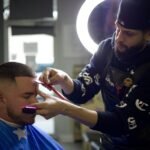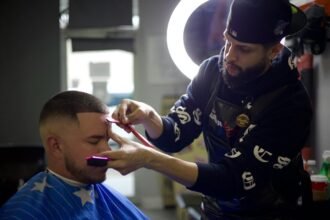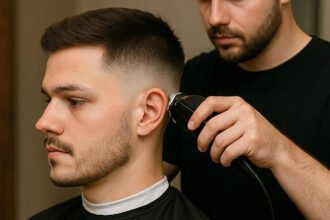You can go from dark to dirty blonde safely, but you’ll need a plan, patience, and the right techniques. Your hair’s porosity, prior color, and scalp health determine how fast and how far you can lift without breakage. Multiple sessions, controlled developers, and bond builders reduce risk. At-home kits often over-process and cause banding. If you want an even, healthy result—and to know when to pause—start by understanding what “dirty blonde” really means for you.
Key Takeaways
- Yes, but plan multiple sessions; lift safely 1–2 levels per visit with 4–8 weeks between to prevent damage.
- Get a pro assessment of natural level, prior color, porosity, and elasticity; strand test to predict undertones and timing.
- Use bond builders during every lightening step and alternate protein and moisture treatments between appointments.
- Expect brass during lift; tone with acidic, ammonia-free glosses every 3–4 weeks to maintain a neutral/ash dirty blonde.
- Choose salon techniques (foils, balayage, root smudge) for controlled lift and softer grow-out; avoid at-home bleaching on previously colored hair.
What “Dirty Blonde” Really Means
Before you mix bleach or book a toner, define “dirty blonde” precisely: it’s a medium-to-dark blonde base (level 6–8) with muted, natural-looking undertones—typically neutral to slightly cool—achieved by balancing warm underlying pigment (gold/copper) with ash or beige tones.
Use a clear dirty blonde definition so you target a controlled, wearable result rather than an overly warm or flat outcome.
You’ll evaluate dirty blonde shades by three variables: level, reflect, and saturation. Level sets depth (6, 7, or 8). Reflect codes tone: N/NA/NV for neutral to cool balance; BA/AB for beige-ash. Saturation governs how prominent the reflect reads in various lights.
Aim for translucent tonality that softens brass without over-matting. Confirm with swatch tests and standardized lighting, and document formulas for repeatable, safe maintenance.
How Lightening Dark Hair Works
Although the goal is a soft blonde, lightening dark hair is a controlled oxidation process that breaks down natural and artificial pigment in stages from red to orange to yellow. You’re removing melanin with alkaline agents and oxidizers, then refining undertones with toners.
Different lightening techniques—on‑scalp bleach, foils, balayage, and gentle oil‑based lifts—alter exposure time, heat, and precision, which affects cuticle swelling, cortex disruption, and porosity.
Technique shapes lift: on‑scalp, foils, balayage, and oil lifts modulate heat, exposure, and fiber porosity.
You manage pH, developer volume, and timing to avoid overprocessing. High developers accelerate lift but raise fracture risk; lower volumes lift slower with better fiber integrity.
Modern hair colorations use persulfates and ammonia or MEA to open the cuticle safely when monitored. You’ll neutralize residual warmth with controlled ash or beige toners and rebuild bonds to maintain elasticity and shine.
Assessing Your Starting Shade and Hair History
Start by identifying your natural level using a standardized hair level chart, since your baseline depth dictates lift requirements and toner selection.
Document all previous color treatments—permanent dyes, box color, henna, glosses, and chemical services—because residual pigment and metal buildup alter processing and increase damage risk.
If you’re uncertain about history or hidden color, perform strand and porosity tests before formulating.
Natural Level Matters
Two factors dictate a safe shift from dark to dirty blonde: your natural level and your hair history. Your natural color determines how many levels you must lift to reach a neutral, beige-blonde target. Map your level at the root under neutral lighting; most brunettes sit at level 3–5, while dirty blonde lives near level 7–8. Greater lift increases alkalinity, processing time, and risk.
Assess porosity, strand diameter, and density. Fine, porous hair lifts quickly but can overprocess; coarse hair resists lift and needs controlled, incremental applications.
Evaluate hair growth patterns—fast growth means visible demarcation sooner and demands conservative formulation. Perform a strand test to verify expected undertones and timing. Use bond-building additives, low developer volumes, and staged lifting to protect structure and maintain scalp integrity.
Previous Color Treatments
Before lifting, document every chemical service on your hair within the last 18–24 months—permanent and demi-permanent dyes, glosses/toners, henna/indigo, direct dyes, bleach, perms/relaxers, keratin/smoothing, and high-heat damage. Your color history dictates porosity, undertone exposure, and lift predictability. Note brand, shade, dates, and overlapping applications. Henna/indigo and metallic salts can react dangerously with bleach; consult a strand test before proceeding. Map banding from mid-lengths to ends to anticipate uneven lift and adjust developer strength, timing, and sectioning.
| Previous Service | Likely Treatment Effects | Safety Notes |
|---|---|---|
| Permanent dark dye | Stubborn red/orange bands | Use chelating + color remover first |
| Henna/indigo | Unpredictable heat, breakage | Avoid bleach; test a strand |
| Keratin/relaxer | Increased porosity | Lower developer; extend processing visually |
Perform porosity and elasticity tests. If hair snaps when wet, postpone lightening and rebuild first.
Salon vs. At-Home: Which Route Is Safer?
Curiously, the safest route depends on your hair’s condition, natural level, and color history—but professional supervision generally reduces risk.
In a salon experience, a licensed colorist assesses porosity, elasticity, mineral buildup, and previous dye molecules, then calibrates developer strength, processing time, and sectioning to protect your cuticle. They can perform strand tests, adjust formulas mid-process, and stop lift before structural compromise, minimizing breakage and banding.
If you use at home kits, you lack precise diagnostics and real-time correction. Box developers are often high-volume and universal, increasing the chance of overprocessing, hot roots, or uneven lift.
You also risk overlapping lightener on compromised zones. For safety, choose a salon when you’ve got prior color, fragile hair, or uncertain undertones; DIY only suits virgin, resilient hair.
Choosing the Right Lightening Technique
Although several paths can lift you from dark to dirty blonde, you need a technique that matches your hair’s integrity, starting level, and color history to control damage and undertone.
Begin with a strand test to assess porosity, previous pigment, and how your hair lifts. Then select technique options that minimize overlap and heat.
Choose foilyage or babylights for controlled, gradual lift with softer demarcation. Opt for traditional foils if you need precise saturation and predictable warmth exposure.
Use clay lightener for open-air, lower-swelling applications on fragile or highly porous hair. Reserve on-scalp lightener only for virgin regrowth under strict monitoring.
Ignore lightening myths—purple shampoo won’t lift, and high volume developer isn’t safer or faster.
Prioritize bond builders, conservative developer strength, and meticulous sectioning to protect the cuticle.
Managing Expectations for Timing and Sessions
Expect multiple sessions to reach a controlled dirty blonde, especially if your hair is coarse, previously colored, or very dark.
You’ll need safe intervals—typically 4–8 weeks—between appointments to allow cuticle recovery, stabilize porosity, and monitor scalp condition.
Plan your schedule and budget accordingly, and don’t compress timelines, as rushed processing increases breakage and banding risk.
Session Count Reality
Because lifting dark pigment safely requires controlled, incremental changes, you should plan for multiple salon sessions rather than a single dramatic leap.
Session count reality means your starting level, previous color history, porosity, and scalp tolerance determine how many lifts you can achieve per visit without compromising integrity. Most dark-to-dirty blonde shifts require staged lightening with bond builders and strategic toning.
- Expect 3–6 sessions to reach a stable dirty blonde, adjusting for banding, cosmetic staining, and resistant undertones.
- Your appointment frequency should reflect hair recovery metrics—elasticity, moisture retention, and cuticle condition—not impatience or calendar convenience.
- Each session targets a safe lift increment (typically 1–2 levels), followed by pH rebalancing and protein/moisture calibration.
- Anticipate maintenance toners within the plan; they refine undertone without forcing excessive lift.
Time Between Appointments
You’ve mapped out session counts; now set realistic spacing between them to protect fiber integrity. Prioritize recovery cycles. After a lift, keratin bonds and lipid layers need time to rebalance. Aim for an appointment frequency of 6–10 weeks between lightening sessions; coarse, resistant hair tolerates closer to six, while fine or previously processed hair needs eight to ten.
Follow timing guidelines based on porosity, elasticity, and scalp condition assessed at each visit. Use the interval for bond-building treatments, moisture/protein calibration, and low-heat styling. If you observe increased porosity, elasticity loss, or scalp irritation, extend the gap one to two weeks.
Schedule toner refreshes or root smudges at mid-interval without additional lift. Don’t compress sessions for events; accelerate only if integrity metrics remain stable.
The Role of Bond Builders and Protein
While lifting dark pigment to a dirty blonde, bond builders and proteins serve distinct, complementary functions that protect hair integrity.
Bond builders target disulfide bonds disrupted by lightener, reducing breakage and preserving elasticity. Protein treatments replenish keratin-derived amino acids, temporarily patching weak spots in the cuticle and cortex.
Use both strategically, but don’t stack them indiscriminately—overuse of protein can cause rigidity and snap.
- Schedule bond builders in every lightening step; they integrate into the bleach or toner to mitigate structural loss.
- Apply protein treatments between services when hair feels stretchy or mushy; follow with moisture to restore flexibility.
- Perform a strand test to calibrate processing time and assess strength before escalation.
- Monitor porosity and elasticity; adjust bond builders, protein frequency, and developer strength accordingly.
Preventing and Correcting Brassiness
With bonds reinforced and protein balanced, the next risk to manage is unwanted warmth as dark pigment lifts. You’ll expose underlying orange and yellow undertones; manage them with precise pH control and disciplined timing.
Use a low-alkalinity lightener, maintain even saturation, and lift in controlled increments to reduce uneven heat-banding that complicates brassiness correction.
Pre-treat with chelating or mineral-removal products if you have well water or hard-water buildup; metals accelerate warmth and patchy lift.
Keep rinse water cool, and shampoo with a sulfate-free, color-safe cleanser to preserve cuticle integrity.
Employ targeted color balancing between sessions: incorporate violet- or blue-based cleansing treatments matched to your exposed undertone (violet for yellow, blue for orange).
Limit hot tools, use UV filters, and stabilize porosity with acidic leave-ins to maintain neutral, dirty-blonde reflect.
Toner, Gloss, and Root Shadow Essentials
Because lifting exposes raw underlying pigment and porosity, your finish work relies on precise toner selection, controlled glossing, and a strategic root shadow to create a believable dirty blonde and protect fiber health.
Choose toner types that target exposed warmth: violet-blue for orange, blue-green for red, and sheer neutral-beige to refine. Keep developers low (5–10 vol) to avoid over-deposit or swelling.
- Map zones: pre-tone mids/ends to cancel warmth; apply a softer root shadow (one to two levels deeper) to blend lines and preserve depth.
- Time with porosity checks; process visually and rinse at the desired neutral-beige.
- Perform gloss application mid-shaft to ends for pH rebalance, shine, and cuticle refinement.
- Emulsify root-to-end briefly to marry tones; cool-water rinse, then stabilize pH.
Protecting Hair Health During the Process
You’ll protect hair integrity by using a gradual lightening strategy that limits lift per session and respects your hair’s protein-moisture balance.
Before any bleach, you’ll implement strengthening treatments (bond builders, protein masks) to reinforce disulfide bonds and reduce cuticle fracture.
After coloring, you’ll maintain moisture with humectants and emollients, lock in hydration with sealing oils, and schedule bond-repair follow-ups to prevent cumulative damage.
Gradual Lightening Strategy
Although dramatic transformations can be tempting, a gradual lightening plan minimizes structural damage and keeps your hair responsive to future color. You’ll manage porosity, maintain elasticity, and protect cuticles by spacing lifts and targeting small level shifts per session. This gradual shift preserves hair health, reduces banding, and guarantees predictable toning.
- Schedule incremental lifts: move 1–2 levels per session, 6–8 weeks apart, to monitor integrity, adjust formulas, and avoid overexposure.
- Use controlled developers: opt for the lowest effective volume, extend processing time within manufacturer limits, and perform strand tests to prevent uneven lift.
- Segment application: apply to mids/ends first, then roots, to account for scalp heat and avoid hot roots or overlapping damage.
- Neutralize progressively: tone after each lift to counter warmth, refine undertones, and maintain target direction toward dirty blonde.
Strengthening Treatments Pre-Bleach
Before lifting, fortify the fiber so it can tolerate alkalinity and oxidative stress. In the two weeks prior, load hair with protein-peptide complexes and bond builders to increase tensile strength and reduce cuticle disruption. Use strengthening masks 2–3 times weekly; verify hydrolyzed keratin, amino acids, or succinic acid. Layer lightweight pre bleach oils (e.g., coconut, squalane) 12–24 hours before service to reduce swelling and friction without occluding peroxide access. Avoid heavy silicones right before bleaching; they can impede even uptake. Patch-test and strand-test to confirm compatibility and porosity response.
| Product Type | Key Actives | Usage Timing |
|---|---|---|
| Bond builder | Bis-aminopropyl diglycol dimaleate | 1–2x weekly |
| Strengthening masks | Hydrolyzed keratin, peptides | 2–3x weekly |
| Pre bleach oils | Coconut, squalane | 12–24h pre-service |
| Chelating pretreat | EDTA, citric acid | 48–72h pre-service |
Post-Color Moisture Maintenance
Once the bleach and toner rinse out, immediately prioritize water balance and barrier repair to prevent cumulative cuticle erosion. Your hair’s lipid layer is compromised, so target moisture retention first, then reinforce with film-formers and proteins in low doses. Choose hydrating products that combine humectants (glycerin, hyaluronic acid) with occlusives (shea, silicones) to reduce transepidermal water loss.
- Rinse with cool water, then apply an acidic, sulfate-free conditioner to close the cuticle and enhance moisture retention without swelling the fiber.
- Use a peptide- or amino-acid–based mask weekly; avoid heavy keratin immediately post-color to prevent brittleness.
- Layer hydrating products: leave-in humectant, then a lightweight silicone or oil serum for sealing.
- Minimize heat: air-dry or use low heat with a heat protectant containing film-formers (PVP/VA, polyquaterniums).
Aftercare: Shampoo, Conditioner, and Masks
Even with a flawless color service, your hair’s integrity depends on disciplined aftercare: choose sulfate-free, color-safe shampoo, a protein-balanced conditioner, and targeted masks to stabilize the cuticle and preserve tone.
Select shampoo types that are low in surfactant harshness; look for pH-balanced formulas (around 4.5–5.5) and violet or blue pigments to counter warmth without over-depositing. Apply minimal friction, cleanse the scalp first, and let suds pass through lengths.
Choose low-harshness, pH-balanced shampoos; use violet/blue pigments sparingly. Cleanse scalp first, let suds glide through lengths.
Prioritize conditioner benefits that combine lightweight emollients with hydrolyzed proteins and ceramides to reinforce weakened bonds while preventing stiffness. Detangle gently with slip-enhancing conditioners; rinse cool to encourage cuticle closure.
Use masks weekly based on porosity: alternate protein-repair masks with lipid-rich, humectant blends. Limit heat, blot—not rub—dry, and seal with a silicone or ester-based leave-in.
Maintenance Schedule and Touch-Up Tips
With aftercare products in place, set a maintenance cadence that protects lift and controls warmth. Use precise maintenance techniques to stabilize pigment, minimize porosity, and sustain a neutral dirty blonde.
Schedule services by new growth, not calendar alone; your touch up frequency should adapt to hair density, oil production, and exposure to heat, sun, and chlorine.
- Book root lightening every 6–8 weeks if regrowth exceeds 1 cm; micro-blend at 5–6 weeks for high-contrast level 2–3 bases.
- Tone every 3–4 weeks, or sooner if brass reaches level 7–8 warmth; choose ammonia-free, acidic glosses to preserve integrity.
- Perform strand tests before adjusting developers; keep scalp off-limits to high-volume oxidizers.
- Trim ends every 8–10 weeks; seal with lightweight oils and UV filters between appointments.
Cost, Commitment, and When to Pause
Although a dirty blonde shift can be strategic and gradual, you should budget for recurring salon services and product upkeep. Cost considerations include consultation fees, multi-session lightening, toners, treatments, and heat-safe tools. You’re also committing to routine trims and bond-building care to keep porosity and elasticity within safe ranges. Assess commitment levels honestly: if your schedule or finances fluctuate, extend timelines or choose lower-maintenance techniques like lived-in highlights.
| Factor | Guidance |
|---|---|
| Budget | Allocate for 3–6 sessions, toners every 6–8 weeks, and reparative products. |
| Time | Plan 2–4 hours per session; longer for corrective work. |
| Health Check | Pause with breakage, gummy texture, or high shedding. |
| Scalp Status | Halt if irritation, burning, or persistent sensitivity occurs. |
| Alternatives | Opt for balayage, root smudge, or glossing until stability returns. |
When in doubt, pause and reassess with your colorist.
Conclusion
Yes—you can go from dark to dirty blonde safely with a plan. Set realistic goals, consult a pro, and space lightening sessions 4–8 weeks apart. Choose techniques that respect your hair’s history and porosity, and prioritize bond builders, low-volume developers, and controlled processing. Use protein and moisture treatments, sulfate-free care, and UV/heat protection between visits. Monitor elasticity and breakage; if integrity dips, pause and repair. Budget for multiple sessions and maintenance toning. Safety-first pacing delivers the healthiest, most even result.









